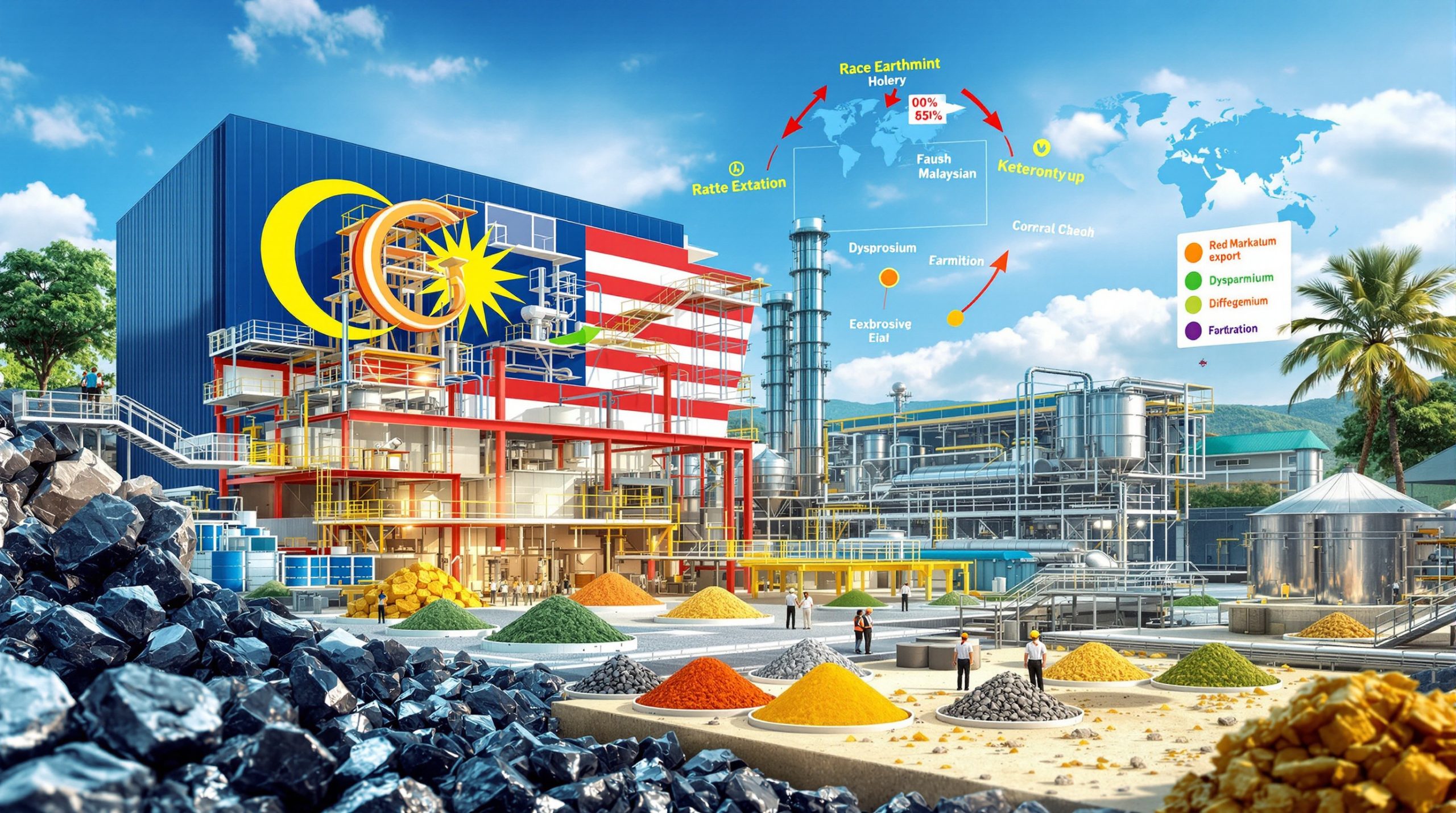The Pilgangoora lithium-tantalum production boost represents a significant milestone in Western Australia's critical minerals landscape, with Pilbara Minerals delivering exceptional operational performance that demonstrates the facility's evolution into a world-class operation. The September quarter results showcase remarkable achievements across production efficiency, cost optimization, and technical excellence that position Pilgangoora among Australia's premier lithium operations.
What Makes Pilgangoora's Recent Production Surge Significant?
Record-Breaking Output Achievements
Pilbara Minerals has achieved remarkable production milestones at its Pilgangoora lithium-tantalum production boost facility, cementing its position as a cornerstone operation in Western Australia's critical minerals sector. The September quarter delivered 224,800 tonnes of spodumene concentrate, representing a steady two percent increase from the preceding quarter and demonstrating consistent operational momentum following the P1000 expansion integration.
This production achievement places Pilgangoora among Australia's leading lithium operations, with the facility now operating at enhanced capacity levels that underscore the technical success of recent infrastructure investments. The consistency in output, particularly during transitional periods following major expansions, reflects sophisticated modern mine planning and execution capabilities that distinguish world-class operations.
Sales performance matched production strength with 214,000 tonnes of concentrate delivered to market during the quarter. This near-alignment between production and sales volumes indicates robust demand channels and efficient logistics coordination, critical factors for maintaining cash flow stability in volatile commodity markets.
Strategic Cost Reduction Success
The most striking aspect of Pilgangoora's recent performance lies in its cost optimization achievements. Unit operating costs on a free-on-board basis declined by a substantial 13 percent to $540 per tonne, demonstrating the operational leverage benefits of scale and improved process efficiency. This cost reduction occurred alongside increased production volumes, highlighting the effectiveness of the owner-operator model implementation.
Furthermore, the owner-operator transition represents a fundamental shift in operational philosophy, bringing direct control over mining activities and enabling more responsive decision-making. This strategic change eliminates contractor margins while providing greater flexibility in resource allocation and operational scheduling, particularly valuable during periods of market volatility.
| Performance Metric | Current Quarter | Previous Quarter | Change |
|---|---|---|---|
| Production Volume | 224,800 tonnes | 220,000 tonnes | +2% |
| Unit Operating Costs | $540/tonne FOB | $621/tonne FOB | -13% |
| Sales Volume | 214,000 tonnes | – | – |
Which Technical Improvements Are Driving Pilgangoora's Enhanced Recovery Rates?
P1000 Expansion Integration Results
The integration of the P1000 expansion has delivered transformative improvements in lithium recovery efficiency, with rates climbing from 71.6 percent to 78.2 percent during the quarter. This represents the strongest recovery performance since the expansion's completion and approaches industry-leading benchmarks for hard-rock lithium operations.
Recovery rate improvements of this magnitude typically result from optimized crushing and screening processes, enhanced dense media separation efficiency, and refined flotation chemistry. The technical achievement becomes more significant when considering the complexity of commissioning new processing equipment while maintaining continuous production from existing circuits.
Modern spodumene processing operations commonly target recovery rates between 75-80 percent, making Pilgangoora's current performance indicative of mature, well-optimized processing conditions. The progression toward these levels suggests successful fine-tuning of operational parameters and equipment performance optimization through direct lithium extraction methodologies.
Mining Volume Optimization Strategies
Mining operations extracted 1.7 million tonnes of ore during the quarter, while total material handling reached 7.7 million tonnes, demonstrating significant operational capacity and waste-to-ore ratio management. These volumes provide crucial insight into the operation's scale and the infrastructure capabilities supporting sustained production growth.
The substantial total material movement indicates comprehensive mine planning that prioritizes long-term ore supply security. This approach becomes particularly important as operations transition into wet season conditions, where access to certain pit areas may become restricted, requiring strategic stockpile management and mining sequence optimization.
Consequently, wet season preparation involves establishing adequate ore stockpiles, maintaining haul road integrity, and ensuring processing plant feed consistency despite potential mining interruptions. The significant material handling capacity provides operational flexibility essential for managing seasonal variations in mining conditions.
How Are Market Dynamics Affecting Pilgangoora's Financial Performance?
Pricing Recovery and Revenue Growth
Lithium pricing demonstrated notable recovery during the quarter, with averaged realised prices increasing 24 percent to US$742 per tonne on a cost, insurance and freight China basis for SC5.3 grade material. When adjusted to SC6 basis, this equates to US$841 per tonne, reflecting the premium associated with higher-grade concentrate specifications.
The distinction between SC5.3 and SC6 concentrate grades carries significant commercial implications. SC6 material contains approximately 6 percent lithium oxide content compared to SC5.3's lower grade, commanding premium pricing due to reduced processing requirements at downstream hydroxide and carbonate conversion facilities.
In addition, revenue performance reflected both volume stability and pricing improvements, climbing 30 percent to $251 million for the quarter. This revenue growth occurred despite modest production increases, highlighting the substantial impact of pricing recovery on operational economics and cash generation capacity.
Balance Sheet Strengthening Indicators
Financial position strengthening became evident through the quarter-end cash balance of $852 million, supplemented by an undrawn $625 million credit facility. This financial capacity provides significant strategic flexibility for navigating market volatility, funding expansion opportunities, or weathering potential downturns in commodity pricing.
The substantial cash position relative to quarterly revenue indicates strong cash generation and conservative financial management. With quarterly revenue of $251 million, the cash balance represents approximately 3.4 quarters of current revenue, providing considerable operational security and strategic optionality.
Credit facility availability adds another layer of financial resilience, enabling rapid response to market opportunities or operational challenges without compromising liquidity. This financial structure positions Pilgangoora advantageously compared to peers with higher leverage or limited access to growth capital.
What Role Does Tantalum Production Play in Pilgangoora's Value Proposition?
Dual-Commodity Production Benefits
Pilgangoora's tantalum production capabilities provide valuable revenue diversification and enhance the operation's economic resilience through exposure to different market dynamics. Tantalum, classified as a critical mineral, serves specialized applications in electronics, aerospace, and medical devices, offering distinct supply-demand fundamentals from lithium markets.
However, the strategic value of tantalum production extends beyond immediate revenue contribution. Critical mineral designation by governments worldwide creates potential for preferential treatment in permitting, financing, and strategic partnership opportunities, particularly relevant as nations develop their critical minerals strategy.
Resource estimates indicate 122 parts per million tantalum pentoxide content across the deposit, representing substantial tantalum resources that contribute to the operation's long-term value proposition. This grade compares favorably with dedicated tantalum operations globally, supporting sustainable by-product production throughout the mine life.
Resource Estimate Growth Analysis
Total resource estimates encompass 446 million tonnes at 1.28 percent lithium oxide, representing substantial scale that supports decades of potential production. Resource confidence and grade consistency become critical factors in long-term planning and investment decision-making for both operators and downstream partners.
The resource base provides optionality for production expansion beyond current capacity levels, supporting potential future growth initiatives as market conditions warrant. Resource scale of this magnitude enables long-term supply agreements with downstream partners seeking production security for planned processing facilities.
Grade consistency at 1.28 percent lithium oxide positions Pilgangoora competitively within the global hard-rock lithium landscape, where deposits commonly range from 1.0 to 1.5 percent lithium oxide. This grade level supports economic processing while providing sufficient margin for operational flexibility during periods of price volatility.
How Are Downstream Partnerships Shaping Pilgangoora's Future Strategy?
POSCO Joint Venture Performance Evaluation
The POSCO Pilbara Lithium Solution joint venture continued operations despite challenging market conditions, with Train 1 producing 2,773 tonnes of lithium hydroxide and Train 2 achieving 2,040 tonnes during the quarter. These production levels reflect moderated batch processing designed to preserve capital during periods of softer global demand.
Train 2's achievement of first customer certification represents a significant milestone, validating product quality standards and enabling commercial sales. Customer certification processes typically involve extensive testing and qualification procedures, making successful completion indicative of mature production capabilities.
Furthermore, the partners' agreement to temporarily reduce 2026 spodumene off-take volumes to approximately 150,000 tonnes provides operational flexibility for Pilbara Minerals while allowing POSCO to manage processing capacity alignment with market demand. This arrangement demonstrates the partnership's adaptive approach to market conditions.
Ganfeng Collaboration Development
Progress in the downstream partnership study with Ganfeng achieved significant milestones through feasibility study completion and commercial framework extension to 2027. This timeline extension reflects the complexity of site selection, market assessment, and the strategic importance of establishing optimal partnership structures.
The feasibility study completion provides technical validation for potential hydroxide production facilities, establishing engineering parameters, cost estimates, and production specifications. These studies form the foundation for investment decisions and detailed engineering phases of potential projects.
Commercial framework extension indicates both parties' commitment to exploring partnership opportunities while allowing sufficient time for thorough evaluation of market conditions, regulatory requirements, and optimal facility configurations through innovative mining industry innovation approaches.
What Infrastructure Developments Support Pilgangoora's Expansion Plans?
Mid-Stream Demonstration Plant Progress
Construction progress on the mid-stream demonstration plant maintains alignment with the December 2025 completion timeline, representing a strategic step toward value-added processing capabilities. Demonstration plants serve as proving grounds for commercial-scale processing technologies while generating technical data essential for full-scale facility design.
The demonstration plant enables evaluation of different processing routes, optimization of operating parameters, and validation of product specifications before committing to larger capital investments. This approach reduces technical risk associated with scaling proven laboratory processes to industrial production levels.
Integration with existing production infrastructure provides operational synergies and reduces capital requirements compared to standalone facilities. Shared utilities, maintenance capabilities, and operational expertise enhance the demonstration plant's effectiveness while minimizing operational complexity.
Logistical Advantages and Operational Efficiency
Pilgangoora's location within Western Australia's established mining region provides access to experienced workforce, specialized service providers, and proven transportation infrastructure. These advantages reduce operational costs, improve maintenance response times, and enhance overall operational reliability.
Transportation access to port facilities enables efficient product delivery to international markets, particularly important given the global nature of lithium supply chains. Established rail and road networks provide multiple transport options and competitive logistics costs.
Critical Insight: Operational advantages derived from regional mining cluster effects include shared infrastructure costs, competitive service provider markets, and established regulatory frameworks that facilitate project development and operational efficiency.
How Does Pilgangoora Compare Within Australia's Lithium Production Hierarchy?
Production Capacity Ranking Analysis
Following P1000 integration, Pilgangoora's annual production capacity approaches 1 million tonnes of spodumene concentrate, positioning the operation among Australia's top three lithium producers by volume. This scale provides significant influence in global lithium markets and attractive partnership opportunities for downstream processors.
Recovery rate performance at 78.2 percent exceeds industry averages for hard-rock lithium operations, indicating superior processing efficiency and resource utilization. Technical performance advantages translate directly into cost competitiveness and profitability, particularly important during periods of price volatility.
Unit cost performance at $540 per tonne FOB positions Pilgangoora favorably within the global cost curve for lithium production. Cost competitiveness becomes increasingly critical as new supply sources enter markets and pricing dynamics evolve with changing demand patterns driven by lithium industry innovations.
Strategic Market Position Assessment
Competitive advantages in cost structure stem from scale economies, technical efficiency, and operational optimization achieved through the owner-operator model. These advantages create defensive positioning during market downturns while enabling profitable operation across broader pricing scenarios.
Production scalability provides optionality for capacity expansion as market conditions warrant, supported by substantial resource base and established infrastructure. Scalability advantages become particularly valuable in rapidly evolving markets where response speed determines competitive positioning.
For instance, market share implications for Australia's lithium sector reflect Pilgangoora's growing influence in global supply chains. As one of the nation's largest producers, operational performance and strategic decisions impact broader sector dynamics and international market perceptions.
What Are the Long-Term Growth Prospects for Pilgangoora Operations?
Expansion Timeline and Capacity Targets
P1000 ramp-up progression toward full capacity operation continues according to planned timelines, with technical performance improvements suggesting successful commissioning and optimization. Full capacity achievement will establish Pilgangoora's position among the world's largest hard-rock lithium operations.
Future production milestone expectations build upon current performance trends and resource base optimization. Sustained production growth requires continued investment in processing capabilities, mining equipment, and infrastructure development to maintain competitive positioning.
Capital investment requirements for sustained growth reflect the capital-intensive nature of mining operations and the need for ongoing equipment replacement, facility upgrades, and productivity improvements. Strategic capital allocation becomes critical for maintaining competitive advantages.
Market Demand Alignment Strategies
Global lithium demand forecasting integration shapes production planning and capacity development decisions. Demand growth driven by electric vehicle adoption and energy storage deployment creates opportunities for sustained production expansion.
Supply chain positioning for battery manufacturers involves establishing relationships with midstream processors and end-users seeking supply security. Strategic partnerships provide demand certainty while enabling premium pricing for quality assurance and supply reliability.
Strategic flexibility in volatile commodity markets requires adaptable operational capabilities and financial resilience. Operational flexibility enables production optimization based on market conditions while financial strength provides staying power during challenging periods.
How Do Environmental and Regulatory Factors Impact Pilgangoora's Development?
ESG Compliance and Sustainability Initiatives
Environmental management system implementation addresses stakeholder expectations for responsible mining practices while ensuring regulatory compliance. Modern mining operations require comprehensive environmental monitoring, impact mitigation, and rehabilitation planning.
Community engagement and social license maintenance involve ongoing dialogue with local communities, traditional owners, and stakeholder groups. Social license considerations increasingly influence project approvals, operational permissions, and access to capital markets.
Regulatory compliance framework adherence encompasses environmental protection, workplace safety, and operational standards established by Western Australian and federal authorities. Compliance excellence reduces operational risk while supporting reputation management.
Critical Minerals Policy Alignment
Australian government strategic priorities integration positions Pilgangoora advantageously within national resource security frameworks. Critical mineral designation provides potential benefits including infrastructure support, research collaboration, and export facilitation.
Export licensing and international trade considerations become increasingly complex as governments implement supply chain security measures. Strategic trade relationships require navigation of evolving regulatory frameworks while maintaining market access.
Supply chain security contributions to national interests align with government objectives for resource sector development and international competitiveness. Strategic mineral production supports national economic objectives and international partnership opportunities.
What Investment Implications Emerge from Pilgangoora's Performance Metrics?
Financial Performance Indicators
Production growth impact on asset valuation reflects operational improvements and market positioning enhancements. Consistent production increases, cost reductions, and pricing recovery create positive valuation momentum for the operation and parent company.
Comparative analysis with peer operations reveals Pilgangoora's competitive advantages in scale, cost performance, and technical efficiency. Relative positioning within the industry influences investment attractiveness and strategic partnership opportunities.
Risk-adjusted return potential assessment considers operational performance, market positioning, and growth optionality against commodity price volatility and operational risks. Strong operational metrics reduce risk while growth potential enhances return prospects.
Market Valuation Considerations
The combination of increased production volumes, reduced operating costs, and improved recovery rates creates multiple valuation catalysts that distinguish Pilgangoora from industry peers. Technical achievements demonstrate operational excellence while financial performance validates strategic investment decisions.
Sustained cost reduction alongside production growth indicates successful operational optimization that should persist as the operation matures. Cost competitiveness provides defensive characteristics during market downturns while enhancing profitability during favorable pricing periods.
Disclaimer: Investment analysis involves forward-looking assessments subject to commodity price volatility, operational risks, and market condition changes. Performance metrics reflect historical results and may not predict future outcomes.
Conclusion: Pilgangoora's Strategic Importance in Global Lithium Supply
Summary of Operational Achievements
The Pilgangoora lithium-tantalum production boost demonstrates exceptional operational execution across multiple dimensions, achieving production growth, cost reduction, and technical improvement simultaneously. The facility's progression toward industry-leading performance metrics establishes its position among premier global lithium operations.
Recovery rate improvements to 78.2 percent, combined with unit cost reductions to $540 per tonne, create sustainable competitive advantages that support long-term profitability across diverse market scenarios. These achievements reflect sophisticated operational management and successful capital investment implementation.
Financial strengthening through improved pricing, stable production, and strong cash generation provides strategic flexibility for navigating market volatility and pursuing growth opportunities. Balance sheet strength supports operational resilience while enabling strategic investment in value-enhancement initiatives.
Industry Impact Assessment
As one of Australia's largest lithium operations, Pilgangoora's performance influences broader sector dynamics and international supply chain security. Operational excellence and capacity expansion contribute to global lithium supply reliability, supporting clean energy transition objectives.
The operation's dual-commodity approach through tantalum production demonstrates resource optimization and diversification strategies relevant across the critical minerals sector. This approach provides operational insights applicable to other multi-commodity development opportunities.
Furthermore, strategic resource security considerations position Pilgangoora as a cornerstone asset within Australia's critical minerals portfolio, supporting national economic objectives and international partnership development in the transition to clean energy technologies.
The facility's success in delivering the Pilgangoora lithium-tantalum production boost showcases the potential for Australian operations to compete effectively in global markets while contributing to domestic economic growth and international supply chain security. This comprehensive operational transformation positions Pilgangoora for sustained success as the global transition to clean energy accelerates.
Source: Australian Mining, Mining Technology
Looking for Your Next Breakthrough Lithium Investment Opportunity?
Discovery Alert's proprietary Discovery IQ model delivers real-time alerts on significant lithium discoveries across the ASX, instantly empowering subscribers to identify actionable opportunities ahead of the broader market. Understand why historic discoveries can generate substantial returns by exploring Discovery Alert's dedicated discoveries page, then begin your 30-day free trial today to position yourself ahead of the market.




